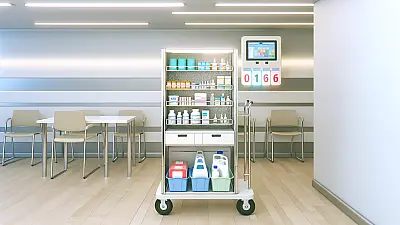EL MONTE, CA - Mayflower Care Center was cited during an August 1, 2024 inspection for failing to maintain accessible and functioning call light systems for residents at high risk for falls, with inspectors finding multiple residents unable to reach emergency assistance devices in their rooms and bathrooms.

Critical Safety System Failures Documented
The inspection revealed systematic problems with the facility's emergency communication system affecting nearly all residents examined. Inspectors found that 10 of 11 residents could not access bathroom call lights when assistance was needed, while 2 residents had call lights wrapped around bed frames and positioned out of reach in their rooms.
The violations are particularly concerning given that all affected residents had documented cognitive impairments and fall histories. Medical records showed residents with conditions including dementia, encephalopathy, schizophrenia, and generalized muscle weakness - conditions that significantly increase fall risk and the need for immediate assistance.
During the inspection, one resident stated she "did not know where her call light was located" when investigators found the cord wrapped around her bed frame. Another resident reported the bathroom call light cord "was missing for quite some time" and that she had "informed the nurses about it, but nothing was done."
Medical Significance of Call Light Access
Call light systems serve as the primary safety mechanism for nursing home residents, particularly those with cognitive impairments who may become confused or disoriented. When residents cannot access these emergency communication devices, the risk of serious injury from falls increases substantially.
Residents with dementia and other cognitive disorders often experience sudden confusion, making immediate access to assistance critical. The bathroom environment presents additional risks, as these spaces typically have hard surfaces and limited maneuvering room. For residents with documented gait abnormalities and muscle weakness, the inability to call for help during bathroom visits creates a dangerous situation.
The facility's own care plans emphasized the importance of keeping call lights "within easy reach" for all affected residents, recognizing their elevated fall risk due to conditions such as impaired cognition, medication effects, and physical weakness.
Staff Recognition of Safety Hazards
Nursing staff interviewed during the inspection acknowledged the safety risks posed by inaccessible call lights. When shown a call light wrapped around a bed rail, one certified nursing assistant stated it "should not be wrapped around the bed rail like that because [the resident] will not be able to reach the call light." The same staff member emphasized that "it is important to have the call light be visible and within reach for [residents] to use to call for help."
Another nursing assistant, upon discovering a bathroom call light cord too short to reach from the toilet, stated the resident "would struggle to call for help if on the toilet and she wouldn't be able to reach a short cord."
Widespread Equipment Malfunctions
Beyond accessibility issues, inspectors documented significant equipment failures. Multiple bathroom call lights failed to activate warning signals when tested, meaning even if residents could reach the devices, nursing staff would not be alerted to emergency situations.
In one instance, a bathroom call light activated the warning signal for an adjacent room rather than the correct resident's room, potentially causing dangerous delays in emergency response. The Director of Nursing acknowledged these malfunctions during the inspection tour and promised to notify administration about the equipment failures.
Facility Policy Violations
The facility's own policies emphasized the critical nature of call light accessibility. The facility's call light policy specifically stated its purpose was "to assure residents receive prompt assistance" and required nursing staff to ensure call lights were "within the resident's reach when in his/her room or when on the toilet."
The facility's accident prevention policy also addressed the importance of maintaining functioning equipment, stating the facility would "repair equipment to prevent defective equipment" as part of providing "an environment that is free from accident hazards."
Additional Issues Identified
The inspection also revealed other concerning patterns, including inadequate fall risk assessments for residents with complex medical conditions. Multiple residents had diagnoses requiring specialized fall prevention protocols, yet their care plans contained only generic interventions rather than individualized safety measures addressing their specific risk factors.
Residents affected by the call light violations had conditions including schizoaffective disorder, chronic kidney disease, epilepsy, major depressive disorder, and various mobility impairments that compound fall risks when emergency communication systems are not functioning properly.
The inspection findings highlight the critical importance of maintaining basic safety equipment in nursing homes, particularly for vulnerable residents with cognitive impairments and physical limitations who depend on these systems for their safety and well-being.
Full Inspection Report
The details above represent a summary of key findings. View the complete inspection report for Mayflower Care Center from 2024-08-01 including all violations, facility responses, and corrective action plans.
💬 Join the Discussion
Comments are moderated. Please keep discussions respectful and relevant to nursing home care quality.